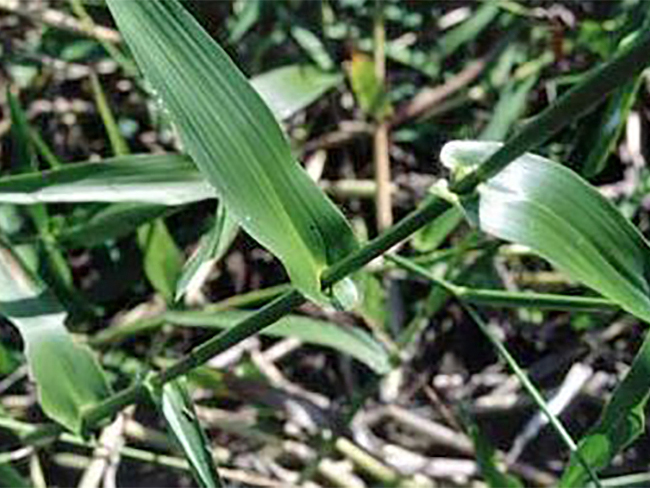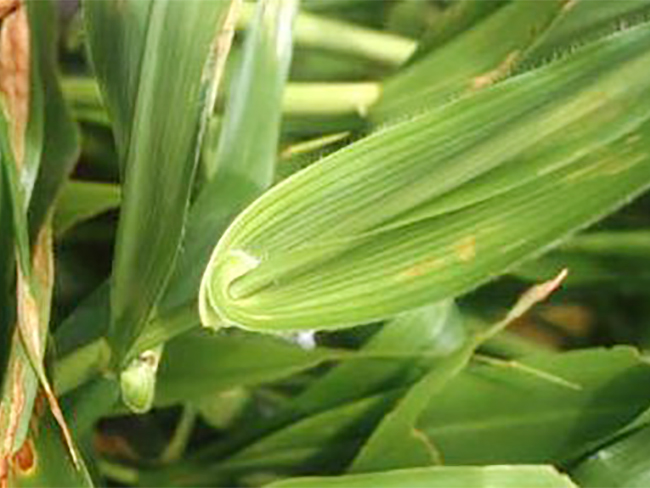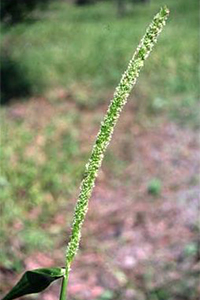Olive hymenachne
Scientific name: Hymenachne amplexicaulis
Declaration status: Class B
Olive hymenachne is a Weed of National Significance. For more information, go to the Australian Government's Department of Environment website.
Olive hymenachne was originally introduced from South America to provide pasture in ponds for cattle in central Queensland.
It has since demonstrated invasive characteristics, by forming dense monocultures in natural wetlands and on agricultural (predominantly sugar cane) land.
It was planted in the tropical wetlands of northern Queensland and the Northern Territory, and is now found mainly in low-lying areas along the edges of permanent water.
It can withstand prolonged flooding (40 weeks) by growing above floodwaters.
It is currently well established across areas of pastoral land located on the floodplains of the Top End, some of which were deliberate planting where it has been used in mimosa control programs as a competitive cover crop.
Impact
Olive hymenachne is regarded as one of the worst weeds in Australia because of its invasiveness, potential for spread, and economic and environmental impacts. It invades permanent water bodies and seasonally inundated wetlands.
Olive hymenachne can have all of the following impacts:
- blocks waterways, potentially causing flooding and threatening drinking water
- threatens fish habitat and nursery areas
- forms dense stands that reduce plant diversity
- reduces available habitat for native animals
- can affect water quality
- has the potential to severely detract from the high conservation and tourism value of natural wetland systems (eg Kakadu National Park)
- reduces open water for water foul
- rapidly replaces wild rice and other native species used by magpie geese.
Identification
You should use this as a guide. There may be other plants or weeds that look similar.
- perennial, robust grass up to 2.5m tall, can grow above or below water with its roots in the ground
- stems float but are not hollow, contain white pith and can produce runners along the ground that root at the nodes
- leaves 10 to 45cm long, leaf base may be covered with long hairs and up to 3cm wide, upper part of the leaf is narrower and without hairs
- leaf blade is heart-shaped at its base where it clasps around the stem
- flowers occur as a cylindrical cluster at the end of a spike, occasionally branched and reach between 20 to 40cm long
- made up of numerous spikelets that are short stalked, 0.3 to 0.5cm long and broadest below the middle (lance-shaped)
- produces large numbers of tiny and viable seeds.
To find out more, get the olive hymenachne weed note on the Department of Lands, Planning and Environment website.
If you are unsure, contact the Weed Management Branch.
Control
Heavy grazing in the dry season can decrease seed production. Mechanical or physical removal is ineffective due to highly effective vegetative reproduction from small fragments.
The use of heavy earth moving machinery to remove hymenachne from drains has met with some success in north Queensland. Aim to reduce plant bulk prior to wet season flooding and drown it. For large infestations contact the Weed Management Branch.
Chemical control
The best time to treat olive hymenachne is from April to May, and then from November to December. Below is a list of treatment methods that can be used.
| Chemical and concentration | Rate | Situation, method and notes |
|---|---|---|
|
Glyphosate 360g/L Various trade names and formulations | 10ml / 1L |
Seedling or adult (individuals or infestation): Foliar spray - apply when actively growing |
Spread
Olive hymenachne is a prolific seeder. Seeds are spread by water, including flooding events, and when transported in mud by animals and birds. It can also spread vegetatively from small plant parts.
Spread prevention
You can prevent the spread of olive hymenachne by doing all of the following:
- contact the Weed Management Branch for advice on controlling large infestations
- map infestations to help develop a management plan
- control minor infestations, isolated outbreaks or seedlings first
- designate wash down areas and actively work to prevent contamination of clean areas
- monitor areas that you have treated and watch for re-infestations.
Give feedback about this page.
Share this page:
URL copied!



